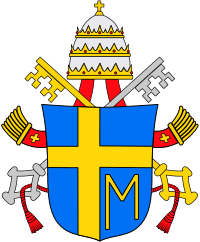The Jeweler's Shop
The Jeweler's Shop (subtitled A Meditation on the Sacrament of Matrimony, Passing on Occasion into a Drama) (Polish: Przed sklepem jubilera) is a three-act play, written in 1960 by Karol Wojtyla (later Pope John Paul II), that looks at three couples as their lives become intertwined and mingled with one another.
The play looks at humanity's ideas and expectations of romantic love and marriage. It is a truthful and animated look at the way people are when in love and their motivations for entering into couplehood.
The play
Act 1 - Signals
Andrew and Teresa are a young couple that have been friends for many years. Recently they have become closer and finally find themselves at the jeweler's shop looking for, and finally buying, wedding rings which unite and bind them in marriage.
Act 2 - The Bridegroom
Stefan and Anna are a couple in a troubled marriage where love does not seem to exist. Their lives are filled with emptiness and disillusionment. Anna meets a stranger at the jeweler's shop, as she tries to sell her wedding ring, and opens her heart to him. However, the stranger reminds her of the Parable of the Ten Virgins and tells her to keep her lamp burning for the bridegroom.
Act 3 - The Children
Christopher (son of Andrew and Teresa) and Monica (daughter of Stefan and Anna) fall deeply in love and both reflect on the lives of their parents and how this has skewed their personal views of love and marriage.
Andrew has died in the war, when Christopher was two, leaving Christopher to fear the pain of losing love. Monica is afraid that marriage will not last because of her parents' troubled marriage.
Renaissance precursor
Four centuries earlier the humanist poet Italian Cardinal Pietro Bembo authored a prose work Gli Asolani (The People of Asoli) using a similar framing device of a marriage feast to explore true love's deeper roots. Refuting a superficial analysis of subjective good vs bad experience, pithily characterized by Bembo as amare (bitter) and amore (sweet), he illustrates a third possibility. Reconciling pain and suffering with happiness and joy, human lovers can aim at the perfection of pure Platonic love, the ideal of cosmic transcendence or everlasting union. The first edition of that work was dedicated to Lucrezia Borgia at whose husband's court he had been retained. While widely read in continental Europe at the time, the work was not translated into English until 1954.
Film adaptation
The Jeweler's Shop was adapted to the screen (La Bottega dell'orefice) by director Michael Anderson and writer Jeff Andrus in 1989 with award-winning actors Burt Lancaster and Olivia Hussey. The film's title used the English spelling "Jeweller" rather than the American "Jeweler".
External links
- The Jeweler's Shop (Hardcover) at The Catholic Company
- The Jeweler's Shop (Hardcover) at Amazon.com
- Information on the film adaptation of the play at IMDb
